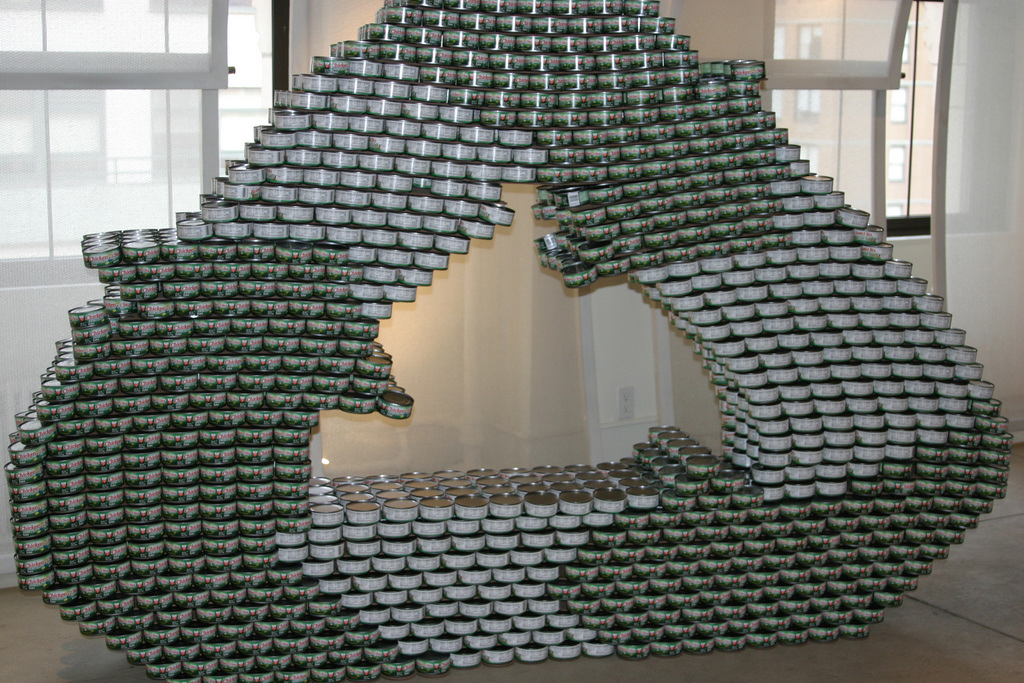|
So here's the deal, plastic despite the many wonderful things we can do with it, is something that we need to change if we are to be able to develop a green sustainable society. Most if not all the plastics you use in your daily life are a fossil fuel derived plastics that are incapable of being recycled in the same way that metal, glass and other common materials can be. Plastic on the other hand is a bit trickier when it comes to recycling. Plastic in the strictest sense cannot be recycled likes metal and glass and is instead put in a process called downcycling. Downcycling is a lot like recycling in that it breaks down and reuses a product but it differs in that there is a marked reduction in quality of the material recycled. For example a plastic water bottle is typically made from virgin plastic and carries a recycling label of 1. When that bottle is recycled the quality of the plastic is reduced and it bumps down in how and what it can be used for. Eventually the plastic is reused so many times that it becomes unusable and must be disposed of. Plastic Recycling We have come along way when it comes to the recycling and reusing of plastic in its many forms. According to the US Energy Information Administration 191 million of barrels of petroleum and natural gas liquids are used to manufacture plastic in the US each year. It took around 65 billion kilowatt hours of electricity to manufacture this plastic but this is only about 1.7% of total US electricity consumption. These numbers represent what it takes to produce the raw plastic pellets that go on to become every plastic product under the sun. In 2012 the US generated 32 million tons of plastic which adds up to around 12.7 % of the total waste generated. Only about 9% or about 3 million tons of the plastic waste was recovered for recycling back into the other plastic products. So essentially we have a very large portion of waste going into landfills that doesn't need to. Recycling is typically much less energy intensive than making something from raw materials and the same holds true for plastic. To recycle one ton of plastic saves
To put in another way if even half of all plastic is recycled it would be like taking 7 million cars off of Americas roads in saved barrels of oil. The most common types of plastic that can be recycled are are the PET and HDPE or numbers 1 and 2. Many cities will take these as part of a recycling program but the plastics past that are not as easy to have taken care of. Below is a list of the types of plastic resins that are manufactured
While a majority of consumer use of plastic could be safely placed into the first two categories there are still quite of bit of plastic products being used that have no option to be recycled. This is serious flaw in the waste management system of this country that needs to addressed. As populations grow their will be more and more plastic waste generated that will need to be dealt with.
Plastic Downcycling Due to the nature of plastic and the way it is created it a very difficult to truly recycle them. When you send a plastic water bottle in for recycling there are a few things that take place. First the bottle is chopped up and pelleted into small chunks. These chunks are then melted down and reformed into other products. For example food and beverage containers are turned into fill for jackets, fleece fabric and bottoms of carpets. Unfortunately once it becomes that type of plastic it is essentially non recyclable and must be thrown away at the end of its lifespan. So you will get 1 maybe 2-3 uses out of a certain amount of plastic before it becomes degraded and is deemed useless. If you compare plastic to steel a very common and heavily recycled material you will find that plastic recycling really pales in comparison. For example,
With increasing populations and demand for plastics, better management of the various plastic resins will be a must for the future. We need to invest in better techniques for recycling what plastic we do have and I believe that as a society we need to move away from fossil fuel plastics all together. While plastic is an amazing material in many ways, it is damaging to the environment at every stage of its life cycle. I won't lie to you I still use plastic in my life. I am typing this article on a plastic keyboard, use plastic Tupperware to store my lunches, freeze meat in freezer safe bags and use plastic grocery bags whenever I forget my cloth ones. But I do my best to recycle the plastic that I use either with a recycling program or by reusing them around the house to grow plants or pick up after my dog on her walks. My point is that plastic is here to stay for now and it is very hard to stay away from it. When you do use it just think to yourself can I recycle this or can it be used at least 3 different ways before it gets throw away. If everyone applied that little bit of thinking we could divert quite a lot of plastic from the landfills into other uses. Sources: http://www.wm.com/location/california/ventura-county/thousand-oaks/recycle/facts.jsp http://www.eia.gov/tools/faqs/faq.cfm?id=34&t=6 http://www.epa.gov/osw/conserve/materials/plastics.htm http://www.project.org/info.php?recordID=383 http://www.eia.gov/tools/faqs/faq.cfm?id=327&t=6 http://www.steel.org/~/media/Files/AISI/Fact%20Sheets/50_Fun_Facts_About_Steel.pdf
0 Comments
Leave a Reply. |
AuthorHello my name is Josh Larson and I am the creator of the Green Living Library. Here on the blog you will find updates to content found in the Green Living Library as well as stories from those living the sustainable life already. Archives
December 2021
Categories
All
|
